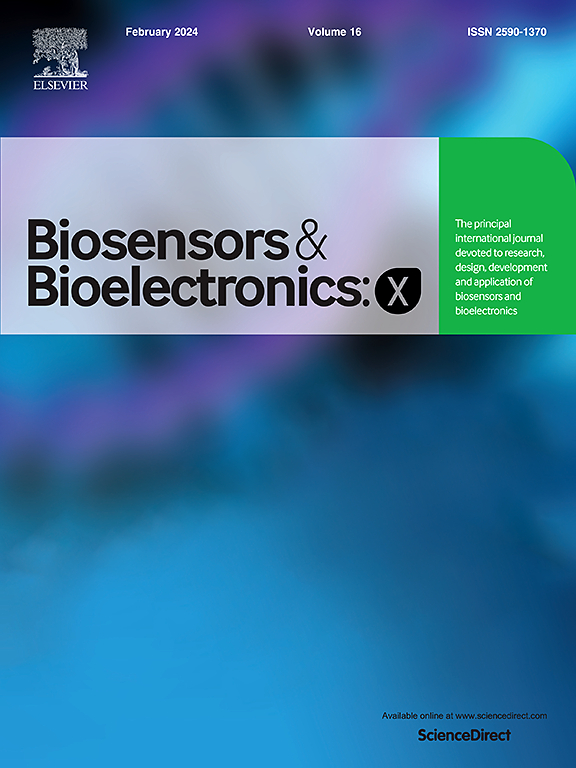利用具有IEDDA化学功能的径向流微流控芯片(ExoOnco ChipEpCAM - TCO)快速、高通量分离肿瘤特异性细胞外小泡
IF 10.61
Q3 Biochemistry, Genetics and Molecular Biology
引用次数: 0
摘要
细胞外囊泡(sev)有望作为早期癌症诊断和预后的生物标志物。基于免疫亲和的特异性sEV表面蛋白抗体分离技术具有高特异性和纯度。然而,研究人员努力分离罕见的sEV亚型,实现足够的吞吐量和管理无害释放。为了应对这些挑战,我们开发了ExoOnco芯片,这是一种微流体装置,具有径向流设计,具有豆状微柱,可创建不同的剪切速率剖面,以实现高效的sEV捕获。该装置集成了无催化剂、生物相容性和双正交反电子需求Diels-Alder (IEDDA),与抗体结合,用于快速、精确地分离罕见的sEV亚型。此外,我们的改性化学包含一个可还原的二硫桥,用于简单释放捕获的sev。我们成功地从细胞系培养基和非小细胞肺癌(NSCLC)患者血浆中捕获并释放了表达高水平上皮细胞粘附分子(EpCAM)的sev。在捕获后,我们展示了使用WB和微量双霉素酸测定鉴定分离sEV的潜力。我们利用患者和健康血浆说明了我们的设备对肿瘤源性sev (TDEs)的特异性,并使用dPCR分析显示TAA表达水平的显着差异。通过实现快速IEDDA化学和功能二硫桥,改进的ExoOnco芯片促进了稀有tde的分离和释放,从而进一步研究其生物活性成分。这项技术为基于这些生物活性成分的早期癌症诊断和适应性免疫疗法的进步开辟了道路。本文章由计算机程序翻译,如有差异,请以英文原文为准。
Rapid, high-throughput isolation of tumor specific small extracellular vesicles using radial flow microfluidic chip with IEDDA chemistry (ExoOnco ChipEpCAM−TCO)
Extracellular vesicles (sEVs) are promise as biomarkers for early cancer diagnostics and prognostics. Immunoaffinity-based isolation techniques using antibodies for specific sEV surface proteins offer high specificity and purity. However, researchers struggle with isolating rare sEV subtypes, achieving sufficient throughput and managing harmless release. To address these challenges, we developed the ExoOnco chip, a microfluidic device featuring a radial flow design with bean-shaped micro-posts that create a varying shear rate profile for efficient sEV capture. This device integrates the catalyst-free, biocompatible, and biorthogonal Inverse electron demand Diels-Alder (IEDDA), conjugated with antibodies for the rapid and precise isolation of rare sEV subtypes. Additionally, our modified chemistry incorporates a reducible disulfide bridge for simple release of captured sEVs. We successfully captured and released sEVs expressing high levels of epithelial cellular adhesion molecule (EpCAM) from cell line media and non-small cell lung cancer (NSCLC) patient plasma. Following captured, we show the potential for characterizing isolated sEV using WB and micro-bicinchoninic acid assay. We have illustrated our device's specificity towards tumor derived sEVs (TDEs) utilizing patient and healthy plasma to show a significant difference in TAA expression level using dPCR analysis. By implementing the rapid IEDDA chemistry and functional disulfide bridge, the improved ExoOnco Chip facilitates the isolation and release of rare TDEs, enabling further investigation of their bioactive constituents. This technology opens avenues for advancements in early-stage cancer diagnosis and adaptive immunotherapies based on these bioactive constituents.
求助全文
通过发布文献求助,成功后即可免费获取论文全文。
去求助
来源期刊

Biosensors and Bioelectronics: X
Biochemistry, Genetics and Molecular Biology-Biophysics
CiteScore
4.60
自引率
0.00%
发文量
166
审稿时长
54 days
期刊介绍:
Biosensors and Bioelectronics: X, an open-access companion journal of Biosensors and Bioelectronics, boasts a 2020 Impact Factor of 10.61 (Journal Citation Reports, Clarivate Analytics 2021). Offering authors the opportunity to share their innovative work freely and globally, Biosensors and Bioelectronics: X aims to be a timely and permanent source of information. The journal publishes original research papers, review articles, communications, editorial highlights, perspectives, opinions, and commentaries at the intersection of technological advancements and high-impact applications. Manuscripts submitted to Biosensors and Bioelectronics: X are assessed based on originality and innovation in technology development or applications, aligning with the journal's goal to cater to a broad audience interested in this dynamic field.
 求助内容:
求助内容: 应助结果提醒方式:
应助结果提醒方式:


